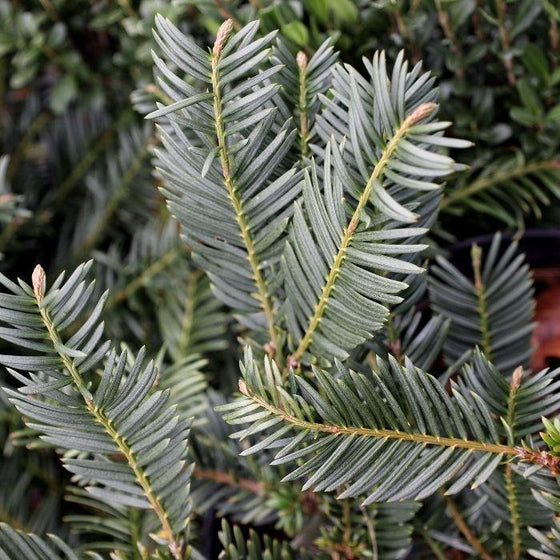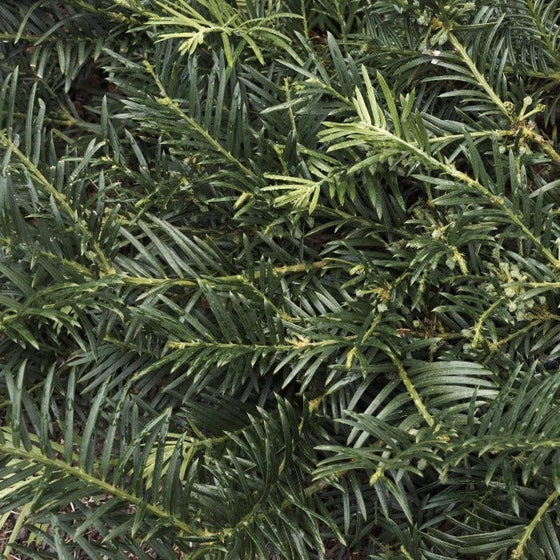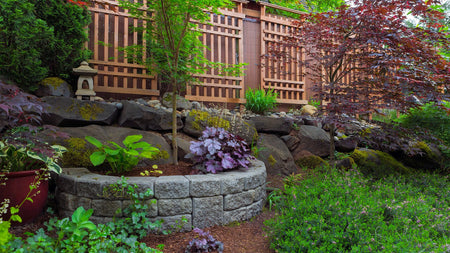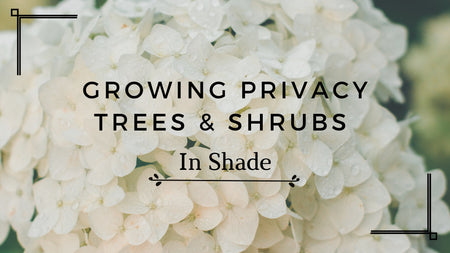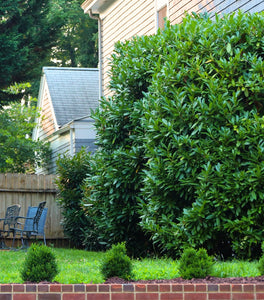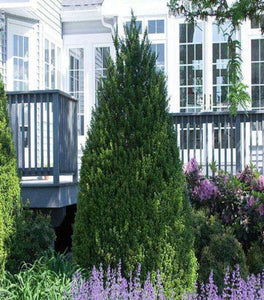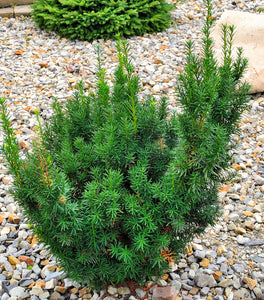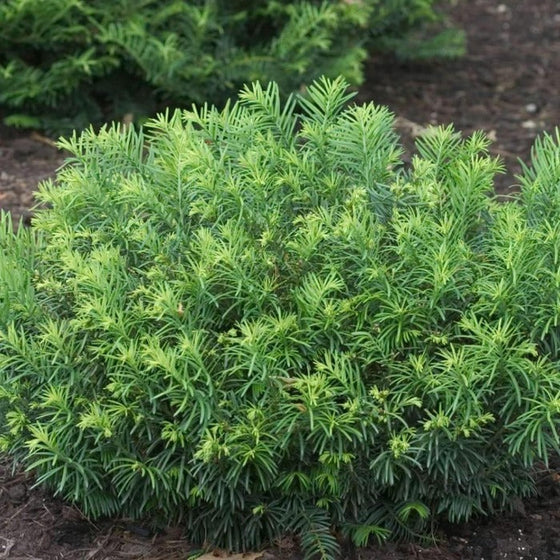
Images Depict Mature Plants
Duke Gardens Plum Yew for Sale Online
The Duke Gardens Plum Yew (Cephalotaxus Harringtonia) is a versatile, low-maintenance evergreen shrub known for its elegant, dark green, needle-like foliage. With its graceful arching branches, this shrub is perfect for adding texture and year-round interest to shady garden areas. Reaching a mature size of 3-4 feet tall and 4-5 feet wide, the Duke Gardens Plum Yew offers a compact, spreading form ideal for foundation plantings, borders, or even as a ground cover in larger landscape designs. Hardy in USDA Zones 6-9, this plant thrives in partial to full shade, making it an excellent choice for shaded gardens where other evergreens may struggle.
One of the key benefits of the Duke Gardens Plum Yew is its adaptability to a variety of soil conditions, as long as the soil is well-drained. Once established, this drought-tolerant shrub requires minimal watering, making it an excellent option for low-water landscapes. Its slow-growing nature means that it requires little pruning, and its deer-resistant qualities make it a reliable choice in areas where deer browsing is a concern. The Duke Gardens Plum Yew is a resilient plant that will provide long-lasting structure and color to your garden with minimal care.
In addition to its use as a landscape shrub, the Duke Gardens Plum Yew can be planted in containers or used as a focal point in shady garden beds. Its compact size and attractive foliage make it suitable for both formal and informal garden designs. Whether you're looking to add greenery to a woodland garden, soften the edges of a shaded pathway, or create a lush, deer-resistant border, the Duke Gardens Plum Yew is a reliable and visually appealing choice that will enhance the beauty and structure of your outdoor space year-round.
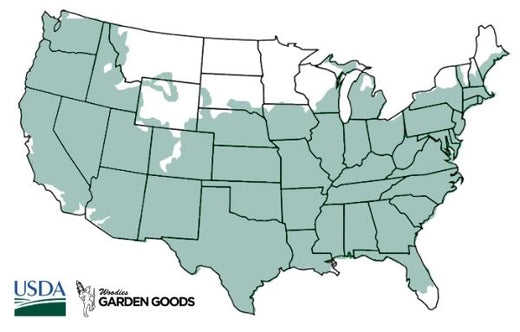
| Hardiness Zone: | 6 to 9 |
|---|---|
| Mature Height: | 3 to 4 feet |
| Mature width: | 4 to 6 feet |
| Classification: | Evergreen shrub / small shrub |
| Sunlight: | Full Sun to Part Shade |
| Habit: | Upright, rounded |
| Foliage: | Dark Green |
| Pruning Season: | Prune in late winter before new growth or after new growth hardens off in summer. |
| Soil Condition: | Any well drained slightly acidic soil |
| Water Requirement: | Water well until established. |
| Uses: | Tolerates heat and drought. Will adapt to slightly moist sites. |
How to Care for Duke Gardens Plum Yew
Be sure to read our planting instructions to ensure a healthy and happy Duke Gardens Plum Yew for years to come!
How Do I Plant a Duke Gardens Plum Yew?
To plant a Duke Gardens Plum Yew, start by selecting a location with partial to full shade, as this evergreen thrives in low-light conditions. Ensure the soil is well-drained, as the plant does not tolerate overly wet soil. Begin by digging a hole twice as wide and as deep as the root ball to encourage healthy root growth. Place the Duke Gardens Plum Yew in the hole, making sure the top of the root ball is level with or slightly above the surrounding soil. Backfill the hole with soil, gently tamping it down to remove air pockets, and water the plant thoroughly to help it settle. Once planted, add a 2-3 inch layer of mulch around the base of the Duke Gardens Plum Yew to conserve moisture, regulate soil temperature, and suppress weeds. This shrub is drought-tolerant once established but will benefit from regular watering during its first growing season to help develop a strong root system. Avoid overwatering, as too much moisture can cause root rot. With proper planting and initial care, the Duke Gardens Plum Yew will reward you with its lush, evergreen foliage, making it a perfect choice for shaded garden beds, borders, or as ground cover.
How Do I Water a Duke Gardens Plum Yew?
Watering a Duke Gardens Plum Yew correctly is key to its healthy growth, especially during the first year after planting. During its establishment phase, water the shrub deeply once a week, ensuring the soil remains evenly moist but not waterlogged. Focus on watering at the base of the plant to allow moisture to reach the root zone, and avoid overhead watering, which can lead to fungal issues. In particularly hot or dry climates, you may need to increase watering frequency slightly during extended periods of drought. Consistent watering during the first growing season will help the Duke Gardens Plum Yew develop a strong and resilient root system. Once established, the Duke Gardens Plum Yew becomes highly drought-tolerant and requires less frequent watering. Check the soil regularly, and water only when the top inch feels dry to the touch. Typically, mature Duke Gardens Plum Yews will need watering every couple of weeks during dry spells. Adding a layer of mulch around the base of the plant helps retain moisture and reduce the need for frequent watering. Proper watering ensures that your Duke Gardens Plum Yew maintains its lush, green foliage and thrives as a low-maintenance addition to your shade garden.
How Do I Fertilize a Duke Gardens Plum Yew?
Fertilizing a Duke Gardens Plum Yew is important for promoting healthy growth and vibrant foliage, especially in its early years. Start by applying a slow-release, balanced fertilizer, such as a 10-10-10 formula, in early spring as the growing season begins. Spread the fertilizer evenly around the base of the plant, taking care to keep it a few inches away from the main stem to avoid burning the roots. Water the area thoroughly after applying fertilizer to help the nutrients penetrate the soil and reach the root zone. This early spring feeding will give the Duke Gardens Plum Yew the nutrients it needs for strong growth throughout the season. For ongoing care, you can supplement with an additional application of fertilizer in mid-summer to keep the Duke Gardens Plum Yew healthy and lush. However, avoid over-fertilizing, as these shrubs are slow-growing and don’t require heavy feeding. Organic alternatives, such as compost or well-rotted manure, can also be applied to improve soil quality and provide steady nutrients over time. With proper fertilization, your Duke Gardens Plum Yew will maintain its dense, evergreen foliage and continue to thrive as a beautiful and low-maintenance shrub in your landscape.

How Do I Prune a Duke Gardens Plum Yew?
Pruning a Duke Gardens Plum Yew is essential for maintaining its compact, attractive shape and promoting healthy growth. The best time to prune this evergreen shrub is in early spring, just before new growth begins. Start by removing any dead, damaged, or diseased branches using clean, sharp pruning shears. This helps improve air circulation and prevents the spread of disease. If the shrub has outgrown its desired size or shape, you can lightly trim back the outer branches, being careful not to remove more than one-third of the plant’s growth at a time. The Duke Gardens Plum Yew has a slow-growing nature, so only minimal pruning is usually required to keep it looking neat and tidy. For ongoing maintenance, inspect your Duke Gardens Plum Yew regularly throughout the growing season and remove any stray branches that may disrupt its natural form. Because of its slow growth, this shrub doesn’t require frequent pruning, making it a low-maintenance option for shady garden areas. Additionally, if you’re using the Duke Gardens Plum Yew as a hedge or foundation planting, light pruning can help maintain its uniform appearance. Proper pruning not only enhances the shape and structure of the shrub but also encourages dense, healthy growth, allowing your Duke Gardens Plum Yew to serve as a beautiful, long-lasting feature in your landscape.

